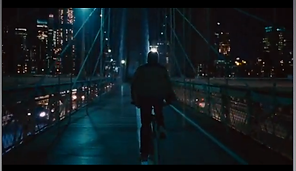Hillary Heras Reyes
Foundation Portfolio

Title sequence - 'The week in the ward'
Our task was to create a 30 second title sequence by reading a synopsis of an unknown film. When we read it, the members of the group who hadn't watched the film (me included) imagined it as a sad, horror drama film which turned out to be the opposite of what the actual film is – a rom-com/ drama. The actual film was ‘It’s kind of a funny story’ (Boden: 2011).
Both films begin by showing their studio companies. Following this begins a non-diegetic voice-over narrated by the protagonist who by the dialogue explains he is about to commit suicide.
Our title sequence follows a restricted narrative focusing on the protagonist, his thoughts and a brief introduction of himself - which serves as action code as it gives an explanation as to why he is in a roof.
Similarly, the actual film's title sequence uses restricted narrative and a non-diegetic voice-over which not only introduces the character but is synchronised with the imagery. For example as he begins saying "It starts on a bridge" the black screen is cut to the long shot of the bridge where the opening sequence begins- this is sharper and grabs the audience’s attention quicker.
The mise-en-scene of both title sequences are very similar, the setting is deserted and there's use of low-key lighting.
However, the editing was used differently. In our title sequence the continuity editing is used to show the all the different angles of Craig (the protagonist) as he walks on the roof. Short takes of the different angles are used to portray this whilst the deep melancholic voice maintains a slow pace that juxtaposes with the sharp, short takes. In addition, we used fade out transitions to cut the scene on to the next suggesting that some time has passed for the protagonist to get down of the roof.
Furthermore, the pace of the camera in the actual film is similarly fast as the camera tracks the character’s movement, cutting from long-shots to close ups and extreme close-ups as well as using panning. Adding on, the actual film also uses birds eye view shot which serves as an establishing shot. Nonetheless, on our title sequence, we used high angle long shots, eye level long shots and low angle long shots, which were also aimed to give a good insight of the setting, as well as creating the omniscient point of view (audience).
Boden's film uses its cinematography to create a suspense mood, the use of cuts and short takes build up tension in the audience as well as intrigue in not knowing what is going to happen. In contrast to this, our opening sequence uses its cinematography as well as non-diegetic score to create a sad, depressing atmosphere making the audience feel empathy for the protagonist.
Surprisingly, the title sequence doesn’t contain any titles apart from the two studios that are mentioned at the beginning and the film’s name. The limited use of title gives little away of the genre or mood this is set specifically by the micro elements.
There’s no mention of the actors or director. I found this quite odd as I was expecting to read the names of actors and therefore anticipate what kind of genre it may be.
Nonetheless, I thought this was a good idea; it made it a lot more interesting to not know who is going to appear.
Our title sequence does contain the name of the main actors. Although we didn’t choose them correctly,
this is because at first we thought of doing a comedy but ended up with something completely opposite.
So this is an area which we would improve on if we were to re- edit it.
Nevertheless, we took time in choosing our font called ‘Indy Pimp’ which helps to represent an indie film and even though our actors weren’t appropriate for the genre we were connoting, they were indie actors nonetheless.
Moreover the group was very creative; our assigned editor learned to use after effects specifically so that we could use stop-motion for the titles. I worked on the score and created an original instrumental using GarageBand plus our location and actor were also an element which we looked into. We went out to Southbank so that we could have a good mise-en-scene and make it look like an actual suicidal scene.
The cinematography; camera cuts, high and low angles help to represent the genre whilst the mise-en-scene; low-key lighting and location support on creating the depressing, sad mood. The sound I think also played a key part in helping to connote the mood of the whole sequence since it links all the other elements together.
In the actual film, the fast pace and comedic dialogue help to portray the genre, the non-diegetic sound is quite silent but also conveys suspense.






